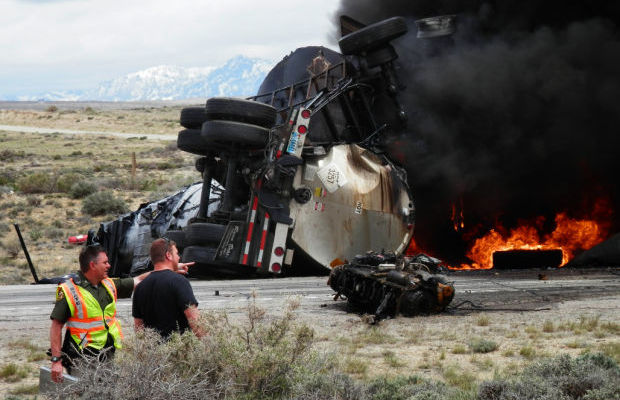
Hampton Young, Contributed
Smoke billows following a head-on collision between two commercial trucks May 16, 2014 on U.S. Highway 287 near Muddy Gap Junction. Two people were killed in the crash. Workplace deaths in Wyoming grew to 34 in 2014, many of which were traffic related.
September 08, 2015
Benjamin Storrow 307-335-5344, Benjamin.Storrow@trib.com
The number of Wyomingites who died on the job in 2014 grew by more than 60 percent over the previous year. That was the major finding of the third annual Fatal & Non-Fatal Injuries report released Tuesday by the state Department of Workforce Services.
It found 34 people died in on-the-job accidents in 2014, up from 21 reported to state officials the previous year. Federal officials recorded 26 workplace fatalities in Wyoming during 2013. The discrepancy is due to varying reporting requirements.
The finding represents a setback for state officials, who have long grappled with how to improve the safety of working conditions in the Cowboy State.
Wyoming consistently ranks among the most dangerous states in the country to work, thanks in part to dangerous driving conditions and the prevalence of high-risk jobs in the energy industry and agriculture.
In 2013, the last year for which nationwide figures were available, Wyoming's workplace fatality rate of 9.5 deaths per 100,000 workers ranked second in the nation behind North Dakota.
“I know the pain a family goes through when a loved one does not return home from work,” Gov. Matt Mead said in a statement. “I am concerned about the increased fatalities in Wyoming."
Oil and gas overtook transportation as the most dangerous sector, accounting for 10 deaths. The industry recorded three deaths in 2013.
The uptick in oilfield deaths, which corresponded with a spike in drilling across the state, was largely due to a change in how Wyoming counts fatalities.
In previous years fatalities were largely classified by cause, meaning if an oilfield driver died in a traffic accident it was counted as a transportation death.
This year's report considers the sector where the deceased person was employed, said State Occupational Epidemiologist Meredith Towle. The change was made to give employers a better sense of the challenges facing their respective industries, she said.
Seven of the 10 oilfield fatalities were traffic-related. Icy conditions, for instance, were cited as the reason for three deadly rollovers involving oilfield workers.
An additional seven people died in the transportation sector incidents, equal to the same number last year. Agriculture recorded four deaths, while three people were killed in the construction sector.
Failure to wear a seat belt was a common cause for traffic related deaths. Five people killed in traffic incidents were not wearing a seat belt, the report found.
Former state Occupational Epidemiologist Mack Sewell issued a call for a seat-belt law prior to his retirement last year. The law would allow police to pull over drivers and cite them for failure to wear a seat belt.
Research shows seat belts are the most effective way to prevent a fatality in a crash, Towle said. Seat belt use has increased in states with seat-belt laws, she noted.
Mead, in his statement, noted efforts Wyoming has made to improve workplace safety, hiring additional safety inspectors, focusing on data collection and offering businesses incentives for taking precautionary actions.
"More work needs to be done so those in the workplace return home safe to their families,” the governor said.
The state hired five additional safety consultants and added two inspectors in 2012. Safety consultants do not conduct inspections but offer consultations to businesses.
A 2014 Star-Tribune investigation found the Wyoming Occupational Safety and Health Administration has had difficulty retaining consultants and inspectors in recent times, with many leaving the public sector for better-paying jobs in the oil patch.
Safety consultations have increased in recent years, but inspections hit a five-year low in fiscal year 2014, the investigation found.